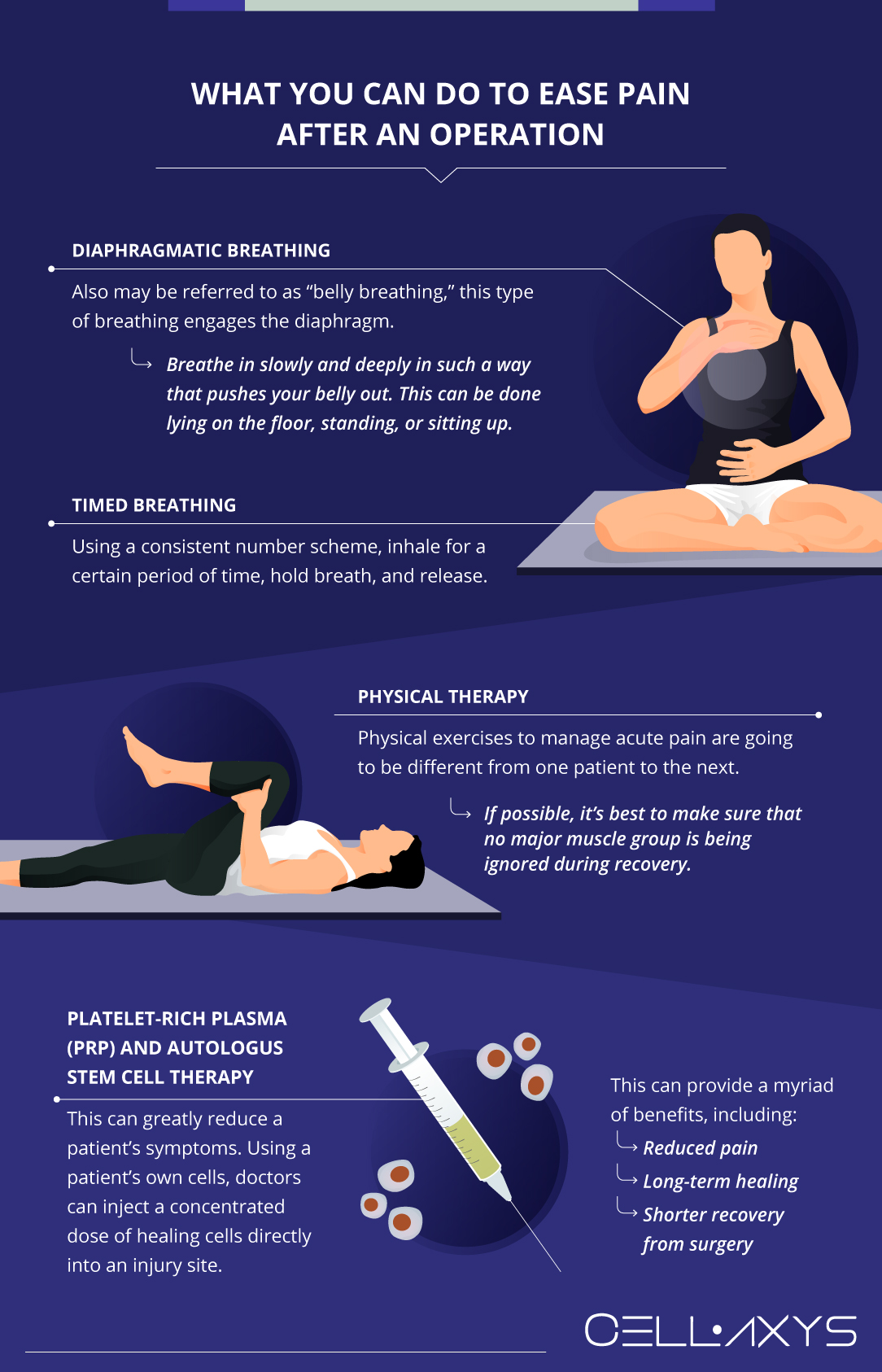Published on: May 18, 2020 | Updated on: August 29, 2024
There are many different types of surgery available for pain sufferers. One person may undergo a minimally-invasive arthroscopy for something as simple as a diagnosis. Another person may elect to have total joint replacement surgery; major surgery with a long and arduous recovery process.
Whatever the reason, there are always risks and potential complications associated with surgery that are worth considering before making this decision.
Some post-surgery exercises exist to ease the pain for patients — each is most often chosen by a medical health professional such as a physiotherapist to meet a patient’s specific needs.
Why Get Surgery?
Most operations are elective, meaning that the patient is ultimately deciding to undergo surgery. An exception to this is emergency surgery, which most likely occurs in the emergency room after a traumatic injury such as a fall or accident.
Whether surgery is meant to treat hip pain, shoulder pain, knee pain, back pain, or something else, it is always the last resort in the treatment process. Doctors will suggest many less invasive treatments before even considering surgery.
Some of the most popular non-surgical treatments for chronic physical pain include:
- Medication: over-the-counter anti-inflammatory drugs can help a patient complete daily tasks that may not be possible due to intense pain. Some examples of this include walking, standing, sitting, and driving. Each can trigger responses, especially in joints such as the hip, knee, and ankle — joints that bear weight throughout the day.
- RICE method: for many sports-type injuries, a combination of rest, ice, compression, and elevation can help ease the symptoms of injury. Ice can ease the pain while rest allows the injury to heal on its own in a way that places minimal stress on the joint. Some doctors may suggest an alternating hot-cold regimen to reduce pain as well. Compression and elevation can ease pain by reducing inflammation at the injury site.
- Physical therapy: the goals of physical therapy are to help a patient regain independence by improving range of motion (which can be affected by an injury), regaining strength surrounding the joint to give it more support, and teaching a patient how to exercise at home in a way that is beneficial to them and their injury.
- Assistive devices: some injuries respond well to assistive devices, especially the weight-bearing joints. Devices such as a brace can hold a joint in place while it heals, to prevent it from healing in an abnormal position. Other devices like a cane or walker can help to ease some of the pressure on a joint by easing the amount of weight put on it.
- Corticosteroid injections: delivering a powerful anti-inflammatory drug to an injury site can be a good way to ease the pain for some. This treatment is not recommended for every patient, however, as it can damage soft tissue over time — so patients with degenerative conditions like arthritis may not benefit from this treatment.
Once doctors have exhausted these treatment methods, they may turn to surgery as the next step in the healing process — if the patient sees little to no results from the aforementioned treatments.
Types of Surgery
Doctors and surgeons will recommend certain surgeries based on the underlying condition and the patient’s specific needs. They most likely will attempt a minimally-invasive surgery before resorting to something like a total joint replacement. Some common types of surgery include:
- Arthroscopy: using a tiny camera for guidance and tiny surgical tools, doctors can make a diagnosis of a condition or make small repairs to an injury. This surgery requires only 1 or 2 small incisions and is not considered major surgery. The recovery time from arthroscopy varies depending on what was accomplished during the procedure and the patient’s needs, but it is generally shorter than major surgery.
- Spinal or bone fusion: pain that is caused by the space between bones can become worn down naturally over time. A solution for this is to remove the soft tissue that is causing problems and fuse two bones. Most fusion surgery is spinal fusion, connecting one vertebra to another, though surgeons can perform bone fusion in other parts of the body like the foot for the same reasons.
- Joint replacement: doctors may decide that a joint is too unstable, degenerated, or dangerous for a patient to continue using. When this occurs, they may elect to replace parts of a joint – or the entire structure. The recovery time for this surgery can be lengthy, and physical therapy can be difficult. This is considered major surgery.
- Decompression/release surgery: some pain and discomfort are caused by compressed nerves or veins. Carpal tunnel syndrome is an example of this. If other treatments fail to relieve symptoms, surgeons can perform surgery to “release” the carpal tunnel. This is performed by cutting a tissue that may be causing structural compression in an attempt to relieve pressure on a nerve.
- Open surgery: a lot of treatments can be performed by a surgeon by simply making an incision and beginning reparative surgery. This may include sewing, sawing, removing damaged or diseased tissue, and much more. Open surgery is ideal when a patient is suffering from multiple injuries concurrently – especially those which cannot be operated on using arthroscopy.
What You Can Do to Ease Pain After an Operation

Trained physiotherapists will guide patients through specific exercises to help with their injuries. An aspect of these exercises that is frequently emphasized is breathing. Being mindful of breath during a challenging physical activity can provide many benefits.
Many individuals benefit from focusing on breathing during a pain attack. This can help to take the mind off of the distracting symptoms, as well as regulate oxygen and prevent anxiety. Some easy breathing exercises to do when experiencing pain are:
- Diaphragmatic breathing: also may be referred to as “belly breathing,” this type of breathing engages the diaphragm. Breathe in slowly and deeply in such a way that pushes your belly out. This can be done lying on the floor, standing, or sitting up. Deep, diaphragmatic breaths can help reduce anxiety, blood pressure, and heart rate.
- Timed breathing: using a consistent number scheme, inhale for a certain period of time, hold breath, and release. A popular example of this is 4-7-8 breathing, which begins with inhaling while you count to 4, holding your breath until the count of 7, and releasing to the count of 8.
Physical exercises to manage acute pain are going to be different from one patient to the next. Injuries like a rotator cuff tear may involve certain shoulder muscles but not use the legs, whereas a hip exercise may include resistance-band guided shuffles, never engaging the shoulder muscles.
If possible, it’s best to make sure that no major muscle group is being ignored during recovery. It can be easy to focus only on the problem area, but doing so can lead to atrophy in the ignored muscle groups or a generally lopsided physique.
Regenerative Medicine for Easing the Pain
Certain regenerative treatments or orthobiologic methods like platelet-rich plasma (PRP) therapy and cell-based therapies can greatly reduce a patient’s symptoms. Using a patient’s own cells or “autologous” tissues, doctors can inject a concentrated dose of healing cells directly into an injury site.
At CELLAXYS, we perform both types of therapies to ease post-surgical pain.
PRP Therapy
PRP therapy isolates platelets from the patient’s blood plasma, processes them, and reinjects them into the injury site to promote healing. Platelets are the healing components of the body as they contain 10 Growth Factors to boost the recovery process. They also release chemical signals to attract healing cells from the blood and produce a scaffolding called fibrin.
An increased number of platelets in the injury site reduces pain and promotes early healing. PRP is performed within 45 minutes.
Cell-Based Therapies
Also known as stem cell therapies, these treatments extract the patient’s healthy cells from two areas, adipose (fat) tissue and bone marrow, process them, and reinject them into the injury site.
When the cells are taken from your adipose tissues, the process is called Minimally Manipulated Adipose Tissue (MMAT) transplant. When the doctor harvests highly concentrated cells from the bone marrow, the process is called Bone Marrow Concentrate (BMAC). Both types of cell-based therapies are performed within 1.5 to 2 hours.
PRP and cell-based therapies are outpatient procedures, meaning you can go home after the process. They can provide myriad benefits, including reduced pain, long-term healing, and shorter recovery from surgery. The doctors use live X-rays and ultrasounds to detect the injury site.
Contact CELLAXYS today to find out if either is right for your healing process.
Sources
Footnotes
- Komann M, Weinmann C, Schwenkglenks M, Meissner W. Non-pharmacological methods and post-operative pain relief: An observational study. Anesthesiology and pain medicine. 2019;9(2).
- Rathmell JP, Wu CL, Sinatra RS, Ballantyne JC, Ginsberg B, Gordon DB, Liu SS, Perkins FM, Reuben SS, Rosenquist RW, Viscusi ER. Acute post-surgical pain management: a critical appraisal of current practice. Regional Anesthesia & Pain Medicine. 2006;31(Suppl 1):1-42.
- Fan M, Chen Z. A systematic review of non‑pharmacological interventions used for pain relief after orthopedic surgical procedures. Experimental and therapeutic medicine. 2020;20(5):1-.
- Sinatra RS. Current methods of controlling post-operative pain. The Yale journal of biology and medicine. 1991;64(4):351.
- Eisenstein M. Easing the pain. Nature. 2019;573(7773):S13-5.
References
- Postsurgical pain treatment in adults. MedlinePlus. Accessed 2/25/2024.
- Pain Control After Surgery. Cleveland Clinic. Accessed 2/25/2024.
- Managing pain after surgery. Harvard Health Publishing. Accessed 2/25/2024.
CELLAXYS does not offer Stem Cell Therapy as a cure for any medical condition. No statements or treatments presented by Cellaxys have been evaluated or approved by the Food and Drug Administration (FDA). This site contains no medical advice. All statements and opinions are provided for educational and informational purposes only.
Dr Pouya Mohajer
Author
Pouya Mohajer, M.D. is the Director of Spine and Interventional Medicine for CELLAXYS: Age, Regenerative, and Interventional Medicine Centers. He has over 20 years of experience in pain management, perioperative medicine, and anesthesiology. Dr. Mohajer founded and is the Medical Director of Southern Nevada Pain Specialists and PRIMMED Clinics. He has dedicated his career to surgical innovation and scientific advancement. More about the doctor on this page.
Dr Pejman Bady
Contributor
Dr. Pejman Bady began his career over 20 years ago in Family/Emergency Medicine, working in fast-paced emergency departments in Nevada and Kansas. He has served the people of Las Vegas as a physician for over two decades. Throughout this time, he has been met with much acclaim and is now the head of Emergency Medical Services in Nye County, Nevada. More about the doctor on this page.









